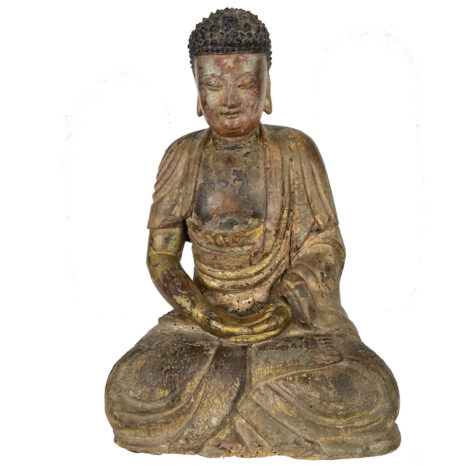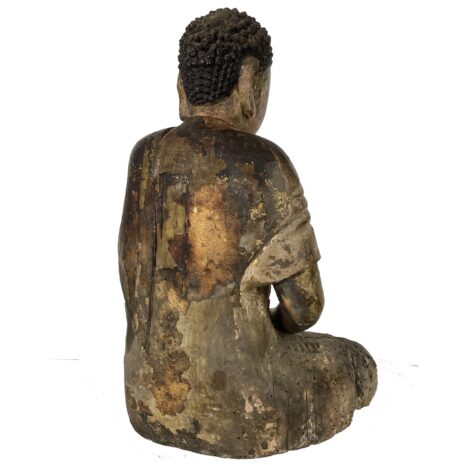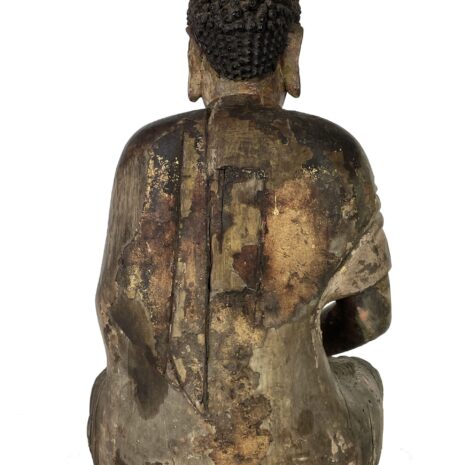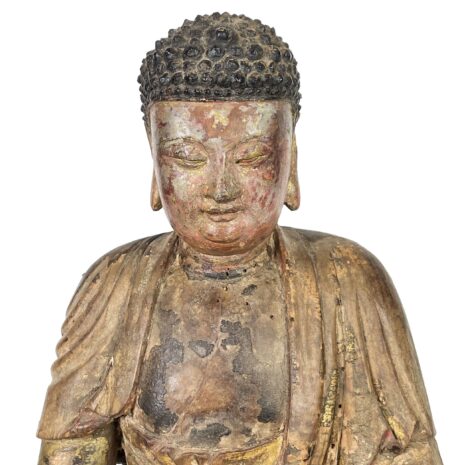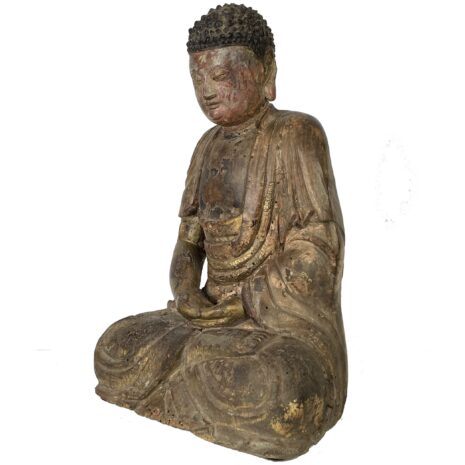Ming Buddha in Meditation, China, (16089)
Original price was: $3,200.00.$2,300.00Current price is: $2,300.00.
H: 14” W: 9.375” D: 7.25” | FOR SHIPPING INFORMATION CONTACT US AT 213-568-3030
Rare small yet majestic carving of the Buddha in meditation with gracefully draped robes and beautifully idealized features that radiates serenity, compassion and spirituality. A truly magnificent piece.
Description
Although there have been countless Buddhas, only Shakyamuni is the historical figure who lived on earth and was the source of teachings that became Buddhist doctrine. He sits in meditation (dhyana) denoting perfect physical and spiritual balance, legs in padmasana, one bare foot faced up and hands in meditation (dhyana). As the posture he assumed under the Bodhi tree before his enlightenment it is the most common Mahayana Buddhism pose in the Ming/Qing dynasties symbolizing his profound state of inner peace, wisdom, and compassion.
Ming dynasty wooden Buddhas are known for their voluminous, naturalistic forms, stylized features, and elegant, flowing robes. Here he wears the traditional simple by gracefully carved three-part monks robe with a shawl over his shoulders and back. His idealized perfected and almost symmetrical facial features and body attest to his status as a divine being. His modestly downcast eyes and blissful smile also conform his sacred status.
This carving portrays him with identifying characteristics referred to as lakshanas: three neck creases symbolizing luck, an ushnisha, a raised cranial protuberance denoting the seat of intellectual powers, wisdom, and divine energy and a bump in the ushnisha called a nikkeishu in Japanese that is a jewel radiating the light of wisdom. His head is snail-crowned, with raised rounded spiral curls, an allusion to when he was lost in meditation snails in gratitude for his love for all sentient beings formed a protective hood. According to the Laita-Vistara which recounts Shakyamuni’s life, he had a “…large skull, broad forehead…skin fine and the color of gold; his hair black and curly.”
Medium antique Buddha images are rare as they were not commonly used in home or community shrines. This one likely was placed on a community shrine. It has some old insect and deterioration from age or conditions during China’s modernization. Repairs were commonly made by Buddhist temple artisans with assistance from donors who financed them to gain merit. It was composed of two pieces seen from the underside front partially covered with a tightly woven gauze-like textile. This might have replaced an original damaged section as it was common for both white paint and white textiles to cover damaged sections. It does not affect the carving’s integral structure or beauty. The concealed closing its back cavity indicates it was consecrated.
Click here for Consecrating Wooden Images to Imbue Them with A Life Force.
Sources:
Fredrick W. Bunce, A Dictionary of Buddhist and Hindu Iconography, New Delhi, D. K. Printworld (P) Ltd., 2001.
Patricia Eichenbaum Karetzky, Images of Asia: Chinese Buddhist Art, New York, Oxford University Press, 2002.
Meyer McArthur, Reading Buddhist Art: An Illustrated guide to Buddhist Signs and Symbols, London, Thames and Hudson, 2002.
C.A.S. Williams, Chinese Symbols and Art Motifs, New York, Dover Publications, 1978.
Additional information
| Place of Origin | China |
|---|---|
| Period | Antique, Ming/Qing Dynasties |
| Date | 17-18th Century |
| Materials and Technique | Wood |
| Dimensions (inches) | Ht: 14”. W: 9.375” D: 7.25” |
| Dimensions (metric) | Ht: 35.56cm W: 23.81cm D:18.41cm |
| Condition | Very good, see description |
| Item Number | 16089BMEM |
| Shipping Box Size | Oversized. Call 213-568-3030 or email [email protected] for shipping. |

